Podcast: Play in new window | Download
Subscribe: Apple Podcasts | RSS
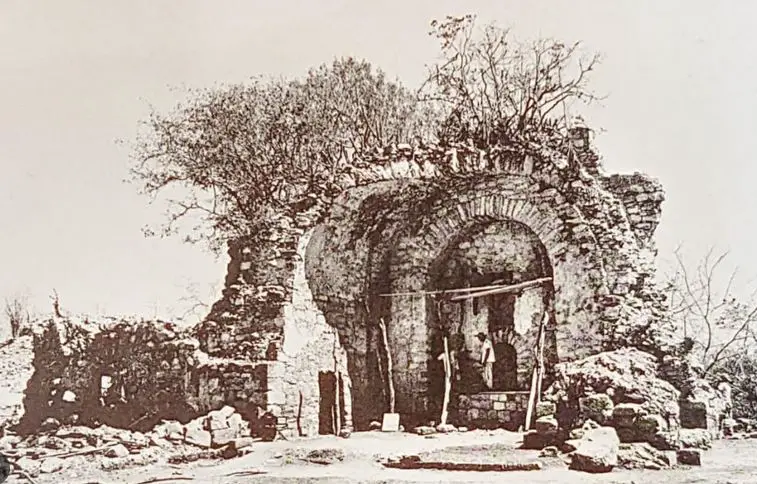 Just before World War II, an American archaeologist and professor at Tulane University named Edward Wyllys Andrews IV, was in Mérida, the capital of the Mexican state of Yucatán. He had heard of an abandoned open chapel to the north of the city on the lands of the Hacienda Chablekal and was curious to investigate it. Professor Andrews was interested in the possibility of finding colonial Spanish pottery on the grounds of the chapel. The structure had been built by the Franciscans in 1592 and served a small local population for 25 years until they abandoned it and built a new house of worship in the actual village of Chablekal a little over 1 mile to the east. When Professor Andrews arrived at the site of the crumbling building, a local guide told him that the area was called Dzibilchaltún, which means in the local Maya dialect, “The Place of Writing on Flat Stones.” Andrews wondered further about the meaning of that place name. The local guide showed him to carved stelae lying flat on the ground and pointed to several mounds covered in vegetation. The Tulane professor quickly shifted his interest from the ruined colonial chapel to the much older and much more significant ruins sheathed in dry tropical forest scrub. His time was short in the Yucatán and Professor Andrews returned home to New Orleans. The outbreak of World War II put his plans to return to the remote corner of Hacienda Chablekal on hold for another 15 years.
Just before World War II, an American archaeologist and professor at Tulane University named Edward Wyllys Andrews IV, was in Mérida, the capital of the Mexican state of Yucatán. He had heard of an abandoned open chapel to the north of the city on the lands of the Hacienda Chablekal and was curious to investigate it. Professor Andrews was interested in the possibility of finding colonial Spanish pottery on the grounds of the chapel. The structure had been built by the Franciscans in 1592 and served a small local population for 25 years until they abandoned it and built a new house of worship in the actual village of Chablekal a little over 1 mile to the east. When Professor Andrews arrived at the site of the crumbling building, a local guide told him that the area was called Dzibilchaltún, which means in the local Maya dialect, “The Place of Writing on Flat Stones.” Andrews wondered further about the meaning of that place name. The local guide showed him to carved stelae lying flat on the ground and pointed to several mounds covered in vegetation. The Tulane professor quickly shifted his interest from the ruined colonial chapel to the much older and much more significant ruins sheathed in dry tropical forest scrub. His time was short in the Yucatán and Professor Andrews returned home to New Orleans. The outbreak of World War II put his plans to return to the remote corner of Hacienda Chablekal on hold for another 15 years.
Andrews gathered together several grants and sponsorships – including a significant one from the National Geographic Society – to re-examine the site in more detail. The professor went back to the Yucatán with a full team in 1956. They had cleared some of the vegetation away from the crumbling ruins back before the war but there was more work to be done. One structure was curious to them. It looked like a big trash heap of discarded stones and bricks, but part of this haphazard mound had collapsed, revealing a very much intact structure underneath. As archaeologists do when they first start mapping sites, Andrews and his team referred to this partially collapsed pile of stones as “Structure One,” and the building beneath it, “Structure One – Sub.” This sub structure, which appeared as if it had been ceremonially buried, was unique at the site which, by 1956, had adopted the formal name of Dzibilchaltún. When the 7,000 tons of rubble were cleared away, the building stood alone in the heart of the ruined city, a half mile from the central plaza, connected to other important structures by a sacbe, or stone road covered in white limestone. This 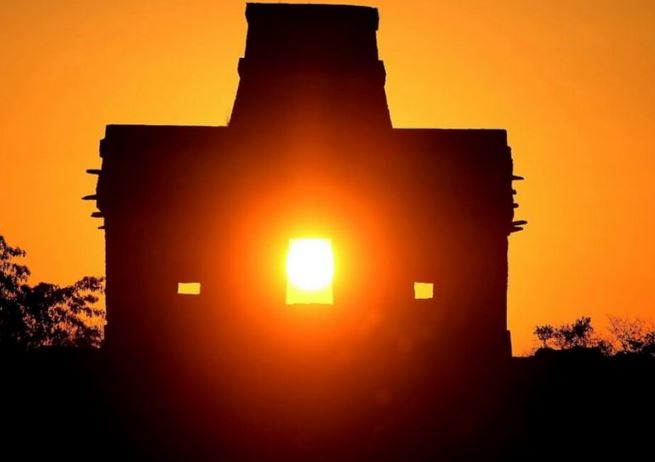 “Structure One – Sub” is a two-tiered pyramid with just 9 steps in each tier, topped by a box-like temple that is taller than the two tiers leading up to it. The temple has 4 arches, one for each cardinal direction. The temple is crowned by a roof vault that is somewhat like a chimney. When standing beneath it, one can see the sky. There is a small doorway on the south side of the temple that allows for access to the roof. When the archaeological team started to excavate underneath this small pyramidal structure, they not only found a much older building beneath it, they found seven figurines placed with careful intent three feet below the floor level in a direct line below the open-air roof vault. It is important to note that these clay figurines were not buried but placed in an open pit in the floor that permitted the dolls to “see” the sky in a figurative sense. The seven figures – 6 women and 1 man – had various physical deformities and are unique in the Maya world. It is from this discovery the building gets its modern name, “The House of the Seven Dolls,” or in Spanish, “La Casa de las Siete Muñecas.” Some researchers and others refer to the building as “The Sun Temple,” because of a phenomenon that has happened only recently. On the equinoxes people flock to Dzibilchaltún to see the sun shine through two opposing arches. Many archaeologists do not think that the temple was set up to be any sort of astronomical marker because there is no stone or any sort of indicator on where to stand to see the sunlight through the doorways. The idea of the temple being somehow linked to the seasons has drawn a large “New Age” type of crowd from North America and Europe, and the ruined city becomes crowded at sunrise on the appointed days as a result. The same group ascribes great power to the 7 dolls discovered in the floor of the temple, and much of that has to do with the fact that archaeologists cannot explain the meaning of the dolls. Some have tried to tie them in to Maya religion or folk tales but have come up empty. Researchers believe that the dolls were buried relatively recently in the long history of Dzibilchaltún: sometime between 1200 AD and 1500 AD. This would correspond to a time of droughts in this part of the Yucatán. Were these dolls made as offerings to appease water spirits? Were they part of some unrelated local folkloric tradition that did not survive into post-Conquest times? In a paper about the site, Professor
“Structure One – Sub” is a two-tiered pyramid with just 9 steps in each tier, topped by a box-like temple that is taller than the two tiers leading up to it. The temple has 4 arches, one for each cardinal direction. The temple is crowned by a roof vault that is somewhat like a chimney. When standing beneath it, one can see the sky. There is a small doorway on the south side of the temple that allows for access to the roof. When the archaeological team started to excavate underneath this small pyramidal structure, they not only found a much older building beneath it, they found seven figurines placed with careful intent three feet below the floor level in a direct line below the open-air roof vault. It is important to note that these clay figurines were not buried but placed in an open pit in the floor that permitted the dolls to “see” the sky in a figurative sense. The seven figures – 6 women and 1 man – had various physical deformities and are unique in the Maya world. It is from this discovery the building gets its modern name, “The House of the Seven Dolls,” or in Spanish, “La Casa de las Siete Muñecas.” Some researchers and others refer to the building as “The Sun Temple,” because of a phenomenon that has happened only recently. On the equinoxes people flock to Dzibilchaltún to see the sun shine through two opposing arches. Many archaeologists do not think that the temple was set up to be any sort of astronomical marker because there is no stone or any sort of indicator on where to stand to see the sunlight through the doorways. The idea of the temple being somehow linked to the seasons has drawn a large “New Age” type of crowd from North America and Europe, and the ruined city becomes crowded at sunrise on the appointed days as a result. The same group ascribes great power to the 7 dolls discovered in the floor of the temple, and much of that has to do with the fact that archaeologists cannot explain the meaning of the dolls. Some have tried to tie them in to Maya religion or folk tales but have come up empty. Researchers believe that the dolls were buried relatively recently in the long history of Dzibilchaltún: sometime between 1200 AD and 1500 AD. This would correspond to a time of droughts in this part of the Yucatán. Were these dolls made as offerings to appease water spirits? Were they part of some unrelated local folkloric tradition that did not survive into post-Conquest times? In a paper about the site, Professor 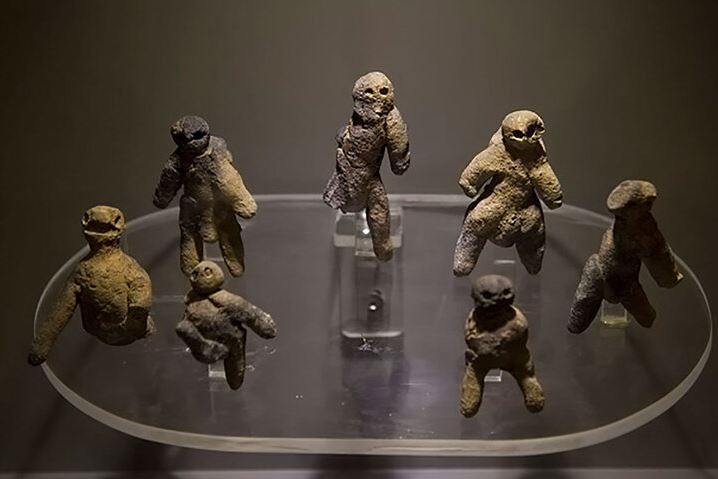 Andrews wrote: “None of us had ever seen anything like them…we can only guess at their significance. Perhaps these little idols embodied the Maya priests’ formulas for curing disease.” Even today, archaeologists can only speculate on the meanings behind these seven unique figures. In the year 2020, a reporter asked a local Maya shaman what he thought the dolls meant and why they were so positioned inside such a sacred place. He remarked that they were probably placed in the temple during a time of great stress when the people of the area were not reproducing. The fact that there was one male, and 6 females was very significant, the elder remarked, and the ceremony behind the figurines could have been a response to a declining population. Again, though, while this explanation may be somewhat intuitive, no one knows for sure.
Andrews wrote: “None of us had ever seen anything like them…we can only guess at their significance. Perhaps these little idols embodied the Maya priests’ formulas for curing disease.” Even today, archaeologists can only speculate on the meanings behind these seven unique figures. In the year 2020, a reporter asked a local Maya shaman what he thought the dolls meant and why they were so positioned inside such a sacred place. He remarked that they were probably placed in the temple during a time of great stress when the people of the area were not reproducing. The fact that there was one male, and 6 females was very significant, the elder remarked, and the ceremony behind the figurines could have been a response to a declining population. Again, though, while this explanation may be somewhat intuitive, no one knows for sure.
And what of the larger context of the House of the Seven Dolls? Dzibilchaltún, it turns out, is one of the most important Maya sites in the northern Yucatán, even though many people outside the immediate area have never even heard of it. Archaeologists believe it to be one the oldest and one of the most continuously occupied of the Maya cities. People started settling there thousands of years ago, possibly during the same time the Olmec civilization flourished on the Gulf Coast. Moderate building began at Dzibilchaltún at around 200 BC, but the city really began to expand around 100 AD. Archaeologists call this the “Early Phase.” There was a small lapse in building at around 600 AD when many major Maya sites started to see the beginnings of collapse. After about a 50-year work stoppage, they began building again. Andrews labeled the period of 650 AD to 1150 AD the “Florescent Period” of Dzibilchaltún where most of its monumental building took place and these buildings had a style much different from the city’s earlier phase. It was during this time that the site had a population of about 20,000 people and like nearby Chichén Itzá, the city took on so-called “Toltec” or more central Mexican characteristics in its art and architecture. The city declined by 1200 AD but still supported a small population that would eventually live among the ruined buildings until the Spanish arrived in the mid-1500s. Many Maya at the time of European contact were living in the nearby village of Chablekal, which still exists today.
Dzibilchaltún has some interesting features besides the House of the Seven Dolls. Its location is very meaningful as it is on fertile land but is as close to the coast as is possible for a settlement. In the 10 miles between the city and the sea are mangrove swamps and rocky areas not suitable for human habitation in prehistory. As previously mentioned, The House of the Seven Dolls is off by itself, but the main road connects it to the central plaza of the city located due east. As with other Maya cities, the main plaza with its many platforms and buildings was home to elite families and priests. Thousands of other humbler homes lost to time spread out in every direction from the center. Besides being located as close as possible to the sea, many scholars believe that the main 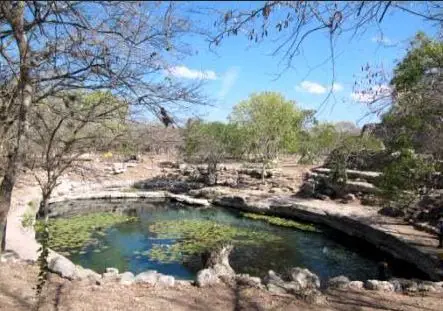 reason why Dzibilchaltún was built in this place was because of the cenote, or freshwater sinkhole, located near the center of the city. Today, locals from the village of Chablekal use the cenote as a swimming hole, but it played a more important role in ancient times. As there is no running surface water in this part of Mexico, the cenote served as a life-giving water source. The cenote is called Xlacah by the locals which means “Old Town” in the Yucatec Maya language. Larger than the sacred cenote at Chichén Itzá in both surface area and volume, it appears that the Dzibilchaltún cenote served much the same purpose as the one at Chichén Itzá. Not only was it the giver of life for the city, but it was also the site of ceremonies to honor various deities. Some 3,000 broken ceramic water jars so far have been recovered from the depths of the cenote along with 8 human skeletons, various animal remains and thousands of other ancient artifacts. Some researchers believe that the cenote was ritualistically tied to the House of the Seven Dolls, but they are still trying to flesh out the connections. There are many dates and other inscriptions carved on monuments and stelae at the city that are also adding to archaeologists’ understanding of the place. In recent times researchers have discovered the real name of the city as inscribed phonetically on a monument: Chi’ y Chaan Ti’ Ho. No one knows what this means.
reason why Dzibilchaltún was built in this place was because of the cenote, or freshwater sinkhole, located near the center of the city. Today, locals from the village of Chablekal use the cenote as a swimming hole, but it played a more important role in ancient times. As there is no running surface water in this part of Mexico, the cenote served as a life-giving water source. The cenote is called Xlacah by the locals which means “Old Town” in the Yucatec Maya language. Larger than the sacred cenote at Chichén Itzá in both surface area and volume, it appears that the Dzibilchaltún cenote served much the same purpose as the one at Chichén Itzá. Not only was it the giver of life for the city, but it was also the site of ceremonies to honor various deities. Some 3,000 broken ceramic water jars so far have been recovered from the depths of the cenote along with 8 human skeletons, various animal remains and thousands of other ancient artifacts. Some researchers believe that the cenote was ritualistically tied to the House of the Seven Dolls, but they are still trying to flesh out the connections. There are many dates and other inscriptions carved on monuments and stelae at the city that are also adding to archaeologists’ understanding of the place. In recent times researchers have discovered the real name of the city as inscribed phonetically on a monument: Chi’ y Chaan Ti’ Ho. No one knows what this means.
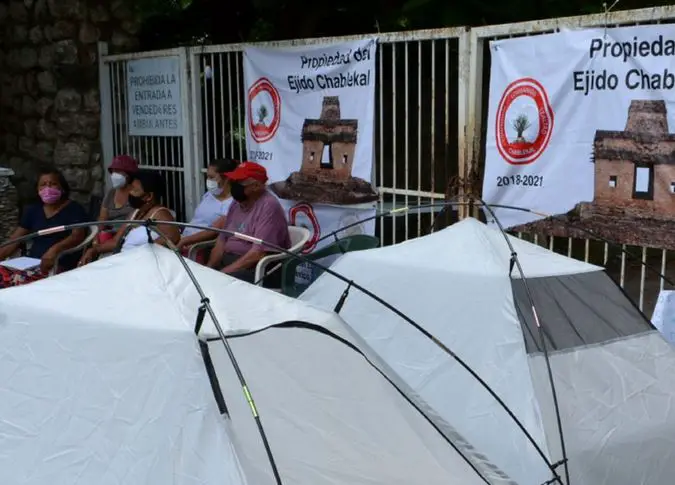 There is an interesting modern-day footnote connected with Dzibilchaltún that is important in the struggle for indigenous rights in the nation of Mexico. In the summer of 2021 protestors shut down the site and refused access to all visitors. When Professor Andrews first arrived on the scene in the 1940s, the ruined city was part of what was then being called the Hacienda of Chablekal. The ruins were located on the ejido of Chablekal, or the communal lands of the Maya people of the village of Chablekal. The modern protest was centered around a claim that the federal government of Mexico appropriated the ruins as federal property in the 1950s without due compensation to the Chablekal villagers who lost part of their ejido in the process. Under Mexican law, all archaeological sites in Mexico are considered federal property and are run by the National Institute of Anthropology and History, or INAH, the agency in charge of safeguarding Mexico’s heritage. The federal government eventually conceded to the demands of the protestors and awarded the villagers 30 million pesos as compensation for their loss. The ruins then opened to the public again in July of 2022. This may serve as a landmark case for other indigenous groups throughout Mexico, but only time will tell.
There is an interesting modern-day footnote connected with Dzibilchaltún that is important in the struggle for indigenous rights in the nation of Mexico. In the summer of 2021 protestors shut down the site and refused access to all visitors. When Professor Andrews first arrived on the scene in the 1940s, the ruined city was part of what was then being called the Hacienda of Chablekal. The ruins were located on the ejido of Chablekal, or the communal lands of the Maya people of the village of Chablekal. The modern protest was centered around a claim that the federal government of Mexico appropriated the ruins as federal property in the 1950s without due compensation to the Chablekal villagers who lost part of their ejido in the process. Under Mexican law, all archaeological sites in Mexico are considered federal property and are run by the National Institute of Anthropology and History, or INAH, the agency in charge of safeguarding Mexico’s heritage. The federal government eventually conceded to the demands of the protestors and awarded the villagers 30 million pesos as compensation for their loss. The ruins then opened to the public again in July of 2022. This may serve as a landmark case for other indigenous groups throughout Mexico, but only time will tell.
REFERENCES
Andrews, E. Wyllys. “Excavations at Dzibilchaltun, Northwestern Yucatan, Mexico.” Proceedings of the American Philosophical Society, vol. 104, no. 3, 1960, pp. 254–65.
INAH web site (in Spanish)
